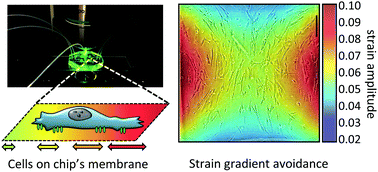当前位置:
X-MOL 学术
›
Integr. Biol.
›
论文详情
Our official English website, www.x-mol.net, welcomes your
feedback! (Note: you will need to create a separate account there.)
Cellular orientation is guided by strain gradients
Integrative Biology ( IF 1.5 ) Pub Date : 2017-05-23 , DOI: 10.1039/c7ib00019g Sophie Chagnon-Lessard 1, 2, 3, 4, 5 , Hubert Jean-Ruel 4, 5, 6, 7 , Michel Godin 1, 2, 3, 4, 5 , Andrew E. Pelling 1, 2, 3, 4, 5
Integrative Biology ( IF 1.5 ) Pub Date : 2017-05-23 , DOI: 10.1039/c7ib00019g Sophie Chagnon-Lessard 1, 2, 3, 4, 5 , Hubert Jean-Ruel 4, 5, 6, 7 , Michel Godin 1, 2, 3, 4, 5 , Andrew E. Pelling 1, 2, 3, 4, 5
Affiliation

|
The strain-induced reorientation response of cyclically stretched cells has been well characterized in uniform strain fields. In the present study, we comprehensively analyse the behaviour of human fibroblasts subjected to a highly non-uniform strain field within a polymethylsiloxane microdevice. Our results indicate that the strain gradient amplitude and direction regulate cell reorientation through a coordinated gradient avoidance response. We provide critical evidence that strain gradient is a key physical cue that can guide cell organization. Specifically, our work suggests that cells are able to pinpoint the location under the cell of multiple physical cues and integrate this information (strain and strain gradient amplitudes and directions), resulting in a coordinated response. To gain insight into the underlying mechanosensing processes, we studied focal adhesion reorganization and the effect of modulating myosin-II contractility. The extracted focal adhesion orientation distributions are similar to those obtained for the cell bodies, and their density is increased by the presence of stretching forces. Moreover, it was found that the myosin-II activity promoter calyculin-A has little effect on the cellular response, while the inhibitor blebbistatin suppresses cell and focal adhesion alignment and reduces focal adhesion density. These results confirm that similar internal structures involved in sensing and responding to strain direction and amplitude are also key players in strain gradient mechanosensing and avoidance.
中文翻译:

细胞取向由应变梯度指导
在均匀应变场中已经很好地表征了应变诱导的循环拉伸细胞的重新定向反应。在本研究中,我们全面分析了人类成纤维细胞在聚甲基硅氧烷微器件内受到高度不均匀应变场的行为。我们的结果表明,应变梯度幅度和方向通过协调的梯度回避响应来调节细胞的重新定向。我们提供关键证据,应变梯度是可以指导细胞组织的关键物理提示。具体来说,我们的工作表明细胞能够精确定位多个物理线索在细胞下方的位置,并整合该信息(应变和应变梯度的幅度和方向),从而产生协调的响应。为了深入了解潜在的机械传感过程,我们研究了粘着斑的重组和调节肌球蛋白II收缩力的作用。提取的焦点粘附取向分布与对于细胞体获得的相似,并且其密度由于存在拉伸力而增加。此外,发现肌球蛋白-II活性促进剂calyculin-A对细胞应答几乎没有影响,而抑制剂blebbistatin抑制细胞和粘着斑排列并降低粘着斑密度。这些结果证实,涉及应变方向和振幅的感应和响应的相似内部结构也是应变梯度机械感测和避免的关键因素。提取的焦点粘附取向分布与对于细胞体获得的相似,并且其密度由于存在拉伸力而增加。此外,发现肌球蛋白-II活性促进剂calyculin-A对细胞应答几乎没有影响,而抑制剂blebbistatin抑制细胞和粘着斑排列并降低粘着斑密度。这些结果证实,涉及应变方向和振幅的感应和响应的相似内部结构也是应变梯度机械感测和避免的关键因素。提取的焦点粘附取向分布与对于细胞体获得的相似,并且其密度由于存在拉伸力而增加。此外,发现肌球蛋白-II活性促进剂calyculin-A对细胞应答几乎没有影响,而抑制剂blebbistatin抑制细胞和粘着斑排列并降低粘着斑密度。这些结果证实,涉及应变方向和振幅的感应和响应的相似内部结构也是应变梯度机械感测和避免的关键因素。而抑制剂blebbistatin抑制细胞和粘着斑排列并降低粘着斑密度。这些结果证实,涉及应变方向和振幅的感应和响应的相似内部结构也是应变梯度机械感测和避免的关键因素。而抑制剂blebbistatin抑制细胞和粘着斑排列并降低粘着斑密度。这些结果证实,涉及应变方向和振幅的感应和响应的相似内部结构也是应变梯度机械感测和避免的关键因素。
更新日期:2017-05-23
中文翻译:

细胞取向由应变梯度指导
在均匀应变场中已经很好地表征了应变诱导的循环拉伸细胞的重新定向反应。在本研究中,我们全面分析了人类成纤维细胞在聚甲基硅氧烷微器件内受到高度不均匀应变场的行为。我们的结果表明,应变梯度幅度和方向通过协调的梯度回避响应来调节细胞的重新定向。我们提供关键证据,应变梯度是可以指导细胞组织的关键物理提示。具体来说,我们的工作表明细胞能够精确定位多个物理线索在细胞下方的位置,并整合该信息(应变和应变梯度的幅度和方向),从而产生协调的响应。为了深入了解潜在的机械传感过程,我们研究了粘着斑的重组和调节肌球蛋白II收缩力的作用。提取的焦点粘附取向分布与对于细胞体获得的相似,并且其密度由于存在拉伸力而增加。此外,发现肌球蛋白-II活性促进剂calyculin-A对细胞应答几乎没有影响,而抑制剂blebbistatin抑制细胞和粘着斑排列并降低粘着斑密度。这些结果证实,涉及应变方向和振幅的感应和响应的相似内部结构也是应变梯度机械感测和避免的关键因素。提取的焦点粘附取向分布与对于细胞体获得的相似,并且其密度由于存在拉伸力而增加。此外,发现肌球蛋白-II活性促进剂calyculin-A对细胞应答几乎没有影响,而抑制剂blebbistatin抑制细胞和粘着斑排列并降低粘着斑密度。这些结果证实,涉及应变方向和振幅的感应和响应的相似内部结构也是应变梯度机械感测和避免的关键因素。提取的焦点粘附取向分布与对于细胞体获得的相似,并且其密度由于存在拉伸力而增加。此外,发现肌球蛋白-II活性促进剂calyculin-A对细胞应答几乎没有影响,而抑制剂blebbistatin抑制细胞和粘着斑排列并降低粘着斑密度。这些结果证实,涉及应变方向和振幅的感应和响应的相似内部结构也是应变梯度机械感测和避免的关键因素。而抑制剂blebbistatin抑制细胞和粘着斑排列并降低粘着斑密度。这些结果证实,涉及应变方向和振幅的感应和响应的相似内部结构也是应变梯度机械感测和避免的关键因素。而抑制剂blebbistatin抑制细胞和粘着斑排列并降低粘着斑密度。这些结果证实,涉及应变方向和振幅的感应和响应的相似内部结构也是应变梯度机械感测和避免的关键因素。











































 京公网安备 11010802027423号
京公网安备 11010802027423号